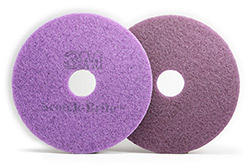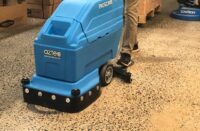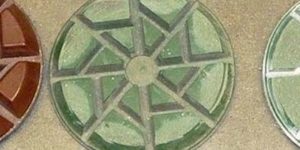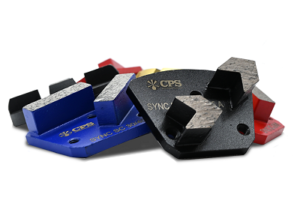Lately, polished concrete floor care with the use of nonwoven diamond floor pad technology (instead of bonded abrasives) has been promoted at conventions, conferences, and in concrete polishing articles everywhere we turn. Just how important are these pads to our polishing industry?
Nonwoven pads were developed more than 50 years ago by 3M, and they still are a huge seller in the janitorial and sanitation market today. Thanks to newer technology such as diamond impregnation, new opportunities and niche industries have opened up too. Manufacturers such as 3M, ETC of Henderson Inc., HTC and Onyx Environmental Solutions now offer ranges of nonwoven diamond pads for different cleaning and restoration processes, all for polished concrete and hard surfaces.
These diamond pads are going to make an impact on our industry, and at this point I am not sure that it is an entirely positive one. Some contractors are using these pads as a crutch to get the shine instead of grinding and refining the right way, using the densifier, and polishing up with effective diamond tooling.
The use of diamond pads to get out of a jam or cut corners is often money- or time-motivated. This article is intended to make you think about when and why you should really use these tools. I recommend that serious concrete polishing craftspeople and trained cleaning professionals buy a set of coarse-to-fine diamond pads and use each for the right reasons and at the opportune time.
First let’s agree on some basics.
Nonwoven diamond floor pads are maintenance and cleaning pads that have been dipped or spray-applied with a coating that has billions of microscopic diamond particles in it. These nonwoven diamonds floor pads come in different grit sizes, similar to bonded abrasives or diamond tooling. However, diamond pad systems cost less and are less hassle than traditional diamond-bonded abrasives and equipment or the never-ending “wax, burnish, clean, strip and begin again” floor care routine.
Diamonds scratch. When a diamond floor pad is attached to a high-speed propane burnisher or a ride-on or walk-behind scrubber, it rotates while in contact with the concrete floor.
As diamond particles scour the concrete floor surface, they remove some of it, whether they are repairing, refining or shining. Different grits will leave coarser or finer scratches depending upon the hardness of the surface, the weight and rotational speed of the equipment, and the pace across the floor.
The key to mastering diamond pad technology for polished concrete is to learn which pads to use, when and why.
The 200- and 400-grit pads
Diamond pads react differently to different surfaces. It is important to find out what you are working on prior to using these tools. Is a film-forming “guard” applied to the polished concrete as a sacrificial wear surface? Is a nonfilm-forming stain protectant applied to the polished concrete? Or is it just “plain old polished” concrete?
Diamond pads with coarse grits of 200 and 400 are aggressive. They should only be used for problem solvers on “plain old polished” concrete. Removing stains, scratches and some surface imperfections gives new life to damaged, heavily worn, or poorly maintained “plain old polished” concrete floors. However, do not use 200s or 400s on film-forming guard coats, as they will severely scratch, haze and damage the guard coatings. Always remove guards before trying to repair a floor.
Choose between the 200 and 400 grit depending upon the level of damage to the floor and the hardness of the concrete. Test them first. Hint: Use the die-cut “donut hole” from the middle of the pad, along with a variable-speed hand grinder, for testing.
Stepping up to 800 grit
Follow-up diamond grits (800-grit plus) should be used on a decorative slab. Where the owner wants some gloss and ease of maintenance. When using a higher grit, the floor’s scratch pattern becomes tighter and more refined. The floor becomes less permeable (making it easier to clean) and shows more reflectivity and clarity.
The 800-grit pad can be used either for the intermediate step after the coarse pads, or for the first step of maintenance when floors have not been well-maintained. This pad removes surface residue and small scratches, resulting in a slightly reflective finish. If a film-forming guard coating has been applied, you must decide to either remove or preserve it. Removing the guard, start from 800s and follow up with the 1,500s.
If preserving the guard coat and applying another, move right up to the more “passive” grits of 1,500 and 3,000.
Consider the 1,500- and 3,000-grit pads only for daily maintenance.
Use the 3,000-grit pads first. Then observe for a week or two whether they achieve the owner’s goals of cleanliness and shine. Evaluate and adjust your recommendation accordingly.
Think about using these pads the way you think about your first cut on a grind-and-polish. The operator’s speed and pace can make a world of difference. And remember, all diamonds scratch the surface, even the 1,500s and 3,000s. In the wrong hands, or with overly aggressive equipment (with too much weight or pad speed), these pads could do more harm than good. If the polished concrete floor is shining up to expectations; coming clean as needed, then the 3,000s are the ticket. Take the 1,500s with you, which will limit the chances for mistakes.
Is the polished concrete is still lacking the desired pop or if the surface is not looking clean enough? Then use the 1,500s until the facility manager’s goals are achieved.
Once the “clean and shiny” goal has been met, switch to the 3,000s for daily use.
The higher the grit level, the finer the refinement of the scratch pattern will be. A few companies manufacture pads of up to 11,000-grit levels. Consider trying these pads once you have been maintaining a polished concrete floor with 3,000-grit pads for an extended period. The 11,000-grit pads can produce an even glossier wet look that may be desirable in certain facilities.
The higher grit levels
















